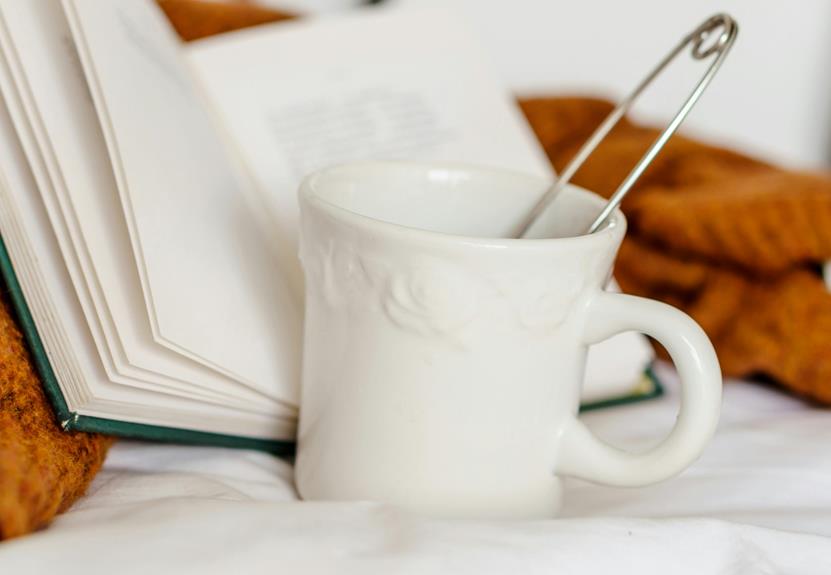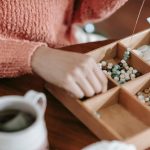If you're looking to add a touch of vintage charm to your projects, tea staining fabric tags might be just the technique you need. You'll want to gather natural fibers like cotton or linen, and prepare your tea solution carefully. Steeping the right blend is crucial, as it can significantly affect the final appearance of your tags. After this initial preparation, you'll be ready to transform plain fabric into something special. But what are some creative ways to use these stained tags once you've finished? Let's explore those possibilities.
Table of Contents
Key Takeaways
- Choose natural fibers like cotton or linen for effective tea staining and optimal color absorption.
- Brew a strong tea solution using black or green tea, adjusting steeping time for desired tint.
- Soak fabric tags in the brewed tea for 15-30 minutes, crumpling for unique patterns if desired.
- Dry tags flat in a ventilated area to avoid creases, then lightly iron on low to remove wrinkles.
Understanding Tea Staining
Tea staining is a simple and effective technique that gives fabric tags a vintage, weathered look. This method uses the natural tannins found in tea to dye fabric, creating a soft, muted hue that's perfect for enhancing your craft projects. It's a great way to add character and charm to plain tags, making them ideal for scrapbooking, gift wrapping, or any DIY project that needs a touch of nostalgia.
When you tea stain, you're not just changing the fabric's color; you're also adding depth and texture. The process mimics the effects of age, making your tags appear as if they've been treasured over time. Plus, it's a low-cost method that's accessible to everyone. Whether you're working with cotton, linen, or muslin, the technique is versatile and easy to adapt to your needs.
You'll find that tea staining is enjoyable and satisfying. As you watch the fabric absorb the color, you'll appreciate the unique results each batch produces. With a little practice, you can master this technique and elevate your fabric tagging game, giving your projects a distinctive, handcrafted feel.
Materials Needed
To get started with tea staining fabric tags, you'll need a few essential supplies.
Choosing the right fabric is crucial for achieving the best results, so keep that in mind as you gather materials.
Once you have everything, preparing the tea solution will be your next step.
Essential Supplies List
Gather the following materials to successfully create beautifully stained fabric tags. Having the right supplies will make your tea staining process smoother and more enjoyable. Here's a handy list to help you get started:
| Material | Purpose | Notes |
|---|---|---|
| Fabric (cotton/linen) | Base for tags | Ensure it's pre-washed |
| Tea (black/green) | Staining agent | Brew strong for darker color |
| Large bowl/pot | Staining container | Preferably non-reactive |
| Strainer | To separate tea leaves | Use a fine mesh |
You might also want to have some paper towels handy for drying the tags and a pair of gloves to keep your hands clean. A pair of scissors will help you cut the fabric into your desired tag size. With these supplies gathered, you're all set to start your tea staining adventure. Enjoy the process of creating unique and rustic tags that can add a special touch to your projects!
Choosing the Right Fabric
Selecting the right fabric is crucial for achieving beautiful and effective tea-stained tags. You'll want to choose a fabric that absorbs tea well and holds the color beautifully. Natural fibers like cotton, linen, and muslin are excellent choices because they soak up the tea solution easily.
Cotton is particularly popular due to its availability and variety of textures, while muslin offers a lovely, rustic look.
Avoid synthetic fabrics like polyester or nylon, as they won't absorb the tea effectively, leaving you with faded or uneven results. If you're looking for a more textured option, consider using burlap or canvas; these materials add a unique flair to your tags.
When selecting your fabric, think about the thickness as well. Thinner fabrics will soak up the tea faster, while thicker ones may require longer soaking times to achieve the desired color.
You might also want to consider pre-washing your fabric to remove any sizing or finishes that could hinder absorption. Ultimately, the right fabric will enhance the overall look and feel of your tags, making your tea-staining project a success.
Happy crafting!
Preparing the Tea Solution
You'll need a few essential materials to prepare your tea solution for staining fabric tags. This process is straightforward, and having the right items on hand will make it even easier. Here's what you'll need:
- Tea Bags: Choose black tea for a rich brown color, or herbal teas for lighter hues. The number of bags will depend on how dark you want the stain. Typically, 3-5 bags work well.
- Water: Use about 2 cups of water. The amount can vary depending on how many fabric tags you plan to stain.
- Pot: A small pot or saucepan will work perfectly to brew your tea. Make sure it's clean and free of any residues from previous cooking.
- Strainer: You'll need a fine mesh strainer or cheesecloth to remove the tea bags, ensuring a smooth solution without any leaves.
Once you've gathered these materials, you're ready to brew your tea solution. Boil the water, steep the tea bags, and let it cool before using it on your fabric tags. Enjoy the beautiful, vintage look that tea staining provides!
Preparing the Fabric
Before diving into tea staining, make sure to prewash your fabric to remove any finishes that could interfere with the dye absorption.
Use a mild detergent and wash it in warm water to ensure all residues are eliminated. This step is crucial because any leftover chemicals can prevent the fabric from soaking up the tea properly, leading to uneven coloring.
Once your fabric is clean, dry it thoroughly. You can either air dry it or use a dryer, but be sure it's completely dry before you start staining.
If you want a more aged look, consider crumpling the fabric slightly before staining; this will create interesting textures and patterns in the final result.
Next, think about the size and shape of your tags. Cut your fabric into pieces that suit your project, keeping in mind the dimensions you need for your tags.
You can opt for straight edges or a more rustic, torn look, depending on your style preferences.
Brewing the Tea
When brewing tea for fabric staining, it's important to select the right type of tea for the desired color and effect.
You'll want to know the best brewing techniques and how long to steep the tea to achieve that perfect shade.
Let's explore these key points to get you started on your tea-staining journey.
Selecting the Right Tea
Choosing the right tea is essential for achieving the desired color and texture in your fabric tags. Different teas can produce various shades and effects, so it's crucial to select one that aligns with your creative vision.
Here are some popular options to consider:
- Black Tea: This tea provides a rich, dark brown hue, perfect for a vintage look. It's one of the most commonly used options for tea staining.
- Green Tea: If you're after a lighter, more subtle color, green tea can give your tags a soft, muted effect. It works well for a delicate aesthetic.
- Herbal Tea: Explore a variety of herbal teas for unique colors. For instance, hibiscus tea can yield a rosy tint, while chamomile offers a golden shade.
- Oolong Tea: This tea sits between black and green, offering a warm, earthy tone. It's a great choice if you want something different yet balanced.
Brewing Techniques Explained
Brewing the tea properly is crucial for extracting the right color and flavor needed for effective fabric staining.
Start by selecting your preferred tea type, whether it's black, green, or herbal, as each brings a unique hue to your fabric. Measure out an appropriate amount of loose tea or tea bags; typically, you'll want about 1 tablespoon of loose tea or 1 tea bag per cup of water.
Next, bring your water to a boil. It's important not to use water that's too hot for delicate teas like green or white, as this can result in bitterness. Once your water's at the right temperature, add the tea and let it steep. Stir it a bit to ensure even extraction.
After steeping, strain the tea if you used loose leaves, and let it cool slightly before using it on your fabric. You want it warm, but not scalding.
The goal here is to achieve a rich, concentrated brew that will impart a beautiful, natural color to your fabric tags. Remember, the longer you allow the tea to brew, the darker and richer the color will be!
Ideal Steeping Time
To achieve the best results in tea staining, it's essential to pay attention to the steeping time, as this directly affects the depth of color on your fabric tags.
If you steep the tea for too short a time, you won't get the rich hue you're looking for. On the other hand, steeping for too long can lead to overly dark or muddy colors.
Here's a quick guide to help you find that sweet spot:
- 1-2 minutes: For a light, subtle tint, perfect if you're aiming for a vintage look.
- 3-5 minutes: This range offers a medium tone, balancing rich color without overwhelming your fabric.
- 6-8 minutes: For a deeper, more robust shade, ideal for tags that need to stand out.
- 10+ minutes: Use this for an extremely dark color, but keep in mind it may overpower your fabric's natural beauty.
Experiment with these times to find what works best for your project.
Staining the Fabric Tags
Start by preparing your tea to achieve the perfect stain for your fabric tags. Choose a strong black or herbal tea, and let it steep for about 10 minutes. This will give you a rich, deep color.
Once your tea is ready, grab your fabric tags and a shallow dish. Pour the tea into the dish, ensuring there's enough liquid to fully submerge the tags.
Next, carefully place each tag into the tea. You can either lay them flat or hang them, depending on your desired effect. If you want a darker stain, let them soak for 15-30 minutes. Keep an eye on the color; you can always remove them sooner if you like a lighter tone.
For a more textured look, try crumpling the tags before placing them in the tea. This technique allows the tea to seep into the folds, creating unique patterns. You might also want to rotate the tags occasionally to ensure even staining.
Once you're satisfied with the color, gently lift the tags out of the tea and let the excess liquid drip off. Now, you're ready to move on to the drying process!
Drying and Finishing Touches
After removing the tags from the tea, lay them flat on a clean, dry surface to allow for proper drying without any unwanted creases.
Make sure the area is well-ventilated to help speed up the drying process. You'll want to avoid direct sunlight, as it can cause the colors to fade unevenly.
Once dried, you can add those finishing touches to enhance their appearance.
Here's a quick list of ideas to consider:
- Ironing: Lightly iron the tags on a low setting to eliminate any wrinkles.
- Distressing: Use sandpaper or a distressing tool to gently roughen the edges for a vintage look.
- Stitching: Consider adding a simple stitch around the edges for a more polished finish.
- Sealing: Apply a fabric sealant or spray to protect the color and ensure longevity.
After completing these steps, your tea-stained fabric tags will be ready for use.
They'll not only look beautiful but also carry a unique, handmade charm that adds character to your projects.
Enjoy the creative process!
Creative Uses for Stained Tags
Tea-stained fabric tags can enhance a variety of projects, adding a touch of rustic charm to your crafts and gifts. You can use these tags as labels for homemade jams or baked goods, giving a personal and vintage feel to your presents. Attach them to jars or boxes with twine for an inviting display.
Consider using stained tags in your scrapbooking projects. They can serve as decorative elements, providing spaces for notes or dates. You can also write messages or quotes on them to accentuate your pages. If you're into journaling, these tags can be great for marking important pages or sections, adding both functionality and beauty.
For home decor, think about stringing several stained tags together to create a garland. This can be a lovely addition to your mantle or wall. Alternatively, use them as bookmarks to enhance your reading experience.
You might also want to incorporate these tags into your gift wrapping. They make lovely gift tags, adding a handmade touch to any present. With so many possibilities, your tea-stained fabric tags can truly elevate your creative endeavors.
Frequently Asked Questions
How Long Do Tea-Stained Tags Last Before Fading?
Tea-stained tags can last several months to a few years before fading, depending on exposure to light and washing. To maintain their appearance, store them in a cool, dark place and handle them gently.
Can I Use Any Type of Tea for Staining?
Yes, you can use any type of tea for staining. Black tea offers the darkest results, while herbal teas can produce unique colors. Experiment with different teas to see which shade you prefer for your projects.
Is Tea Staining Safe for All Fabric Types?
Tea staining isn't safe for all fabrics. Delicate materials like silk or synthetic blends may get damaged or discolored. Always test a small, hidden area first to ensure the fabric reacts well to the staining process.
How Do I Remove Tea Stains if Needed?
To remove tea stains, act quickly. Blot the stain with cold water, then apply a mixture of dish soap and white vinegar. Rinse thoroughly and repeat if necessary until the stain fades away completely.
Can I Add Scents to the Tea for My Tags?
Absolutely, you can add scents to the tea! Just infuse herbs or essential oils while brewing. Experiment with different combinations to create unique aromas that enhance your fabric tags and make them even more delightful.
- How Does Ring Spun Cotton Affect Garment Fit and Shape Retention? - August 13, 2024
- What Are the Challenges in Producing Ring Spun Cotton? - August 13, 2024
- Is Ring Spun Cotton Suitable for Plus-Size Clothing? - August 13, 2024







